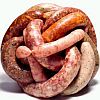York dry cured ham
7 posts
• Page 1 of 1
York dry cured ham
Just seen york dry cured ham on Alan Titchmarsh, how that made. Looks great.
- Sweetcure
- Registered Member
- Posts: 42
- Joined: Fri Mar 27, 2009 12:06 pm
- Location: leicestershire
Sweetcure
From:
http://www.blurtit.com/q666406.html
Basically it's a dry cured ham, the process would be very similar to the one described here:
http://pods.dasnr.okstate.edu/docushare ... 994web.pdf
Hope this helps
Phil
From:
http://www.blurtit.com/q666406.html
A York ham is a leg of pork that has been dry cured using a method traditional to the York region. Current producers describe the process as taking ten weeks. The dry curing process is followed by a maturation period to help the ham develop a greater depth of flavour. Dry curing lends the ham a slightly saltier flavour and drier texture than other hams. The true York ham is said to have been made from the meat of the Large White Pig. However some would have it that the original York Ham was a smoked cured meat which was smoked using the waste timber from the building of York Minster. Dry curing involves cutting the meat from the carcass and rubbing in a mix of salt, saltpetre and sugar. Unfortunately for Yorkshire York ham is not one of those products which has protected regional status. Any ham cured anywhere can be called a York ham if it is cured using the York ham method. In this respect York is like the name of a Chelsea bun or a frankfurter � a generic title which no longer related to the place of its production.
Basically it's a dry cured ham, the process would be very similar to the one described here:
Method of Curing
Curing materials may be in either dry or liquid form. They will be applied either to the surface of meat or into it by some injection method. The oldest method of cure application is dry cure in which the curing ingredients are rubbed on the surface of the meat. The dry, sugar cure method can be used under wider temperature variations and will have less spoilage problems under unfavorable curing conditions. A simple and time-tested dry-curing formula is as follows:
� 8 Ibs. salt
� 3 Ibs. sugar
� 2 oz. sodium nitrate
� 1/2 oz. sodium nitrite (or a total of 3 oz. nitrate available; remember, excess nitrite is toxic)
Also, a prepackaged cure or modern cure mix can be purchased from a spice or seasoning company.
One ounce of cure mixture per one pound of pork should be used. Hams will require three separate rubbings at three- to five-day intervals. Picnics and butts will require two rubbings at three- to five-day intervals. The belly will require one thorough rubbing with a little sprinkling over the flesh side of each belly. The cure mixture should be divided into two or three portions for the number of rubbings. At the end of the three- or five-day interval another portion of the cure mixture should be rubbed in. When curing, meat should be held in a non-corrosive vat or containers that will drain so the cuts do not rest in their own brine.
The length of curing is seven days per inch of thickness. An example, if a ham weighs 12-14 pounds and is 5 inches thick through the thickest part, this ham should be cured 5 x 7 = 35 days. A belly two-inches thick should cure in 14 days. Another important consideration is to be sure the cure is rubbed into the aitch bone joint and hock end of the ham to avoid bone sour. During curing the product should be stored at temperatures between 32� to 40�F.
http://pods.dasnr.okstate.edu/docushare ... 994web.pdf
Hope this helps
Phil
-

wheels - Global Moderator
- Posts: 12894
- Joined: Sat Sep 02, 2006 4:29 pm
- Location: Leicestershire, UK
I've just noticed that the sodium nitrite in this cure is 100% sodium nitrite - as in the UK the curing salt (Cure #1) is 5.88% you would need to use 8½oz cure #1 instead.
This recipe meets US standards but not those set in the EU. You're probably best to use a ready made dry cure, or one of the brine cures specially for ham, on the main site:
http://www.sausagemaking.org/acatalog/B ... r_Ham.html
Phil
This recipe meets US standards but not those set in the EU. You're probably best to use a ready made dry cure, or one of the brine cures specially for ham, on the main site:
http://www.sausagemaking.org/acatalog/B ... r_Ham.html
Phil
-

wheels - Global Moderator
- Posts: 12894
- Joined: Sat Sep 02, 2006 4:29 pm
- Location: Leicestershire, UK
A slight aside: That's the second time today pure sodium nitrite has come up, Spooky...
Anyway, back on track, it shouldn't be too difficult Sweetcure. As Phil says, any more questions, just ask.
Dave
Anyway, back on track, it shouldn't be too difficult Sweetcure. As Phil says, any more questions, just ask.
Dave
Curing is not an exact science... So it's not a sin to bin.
Great hams, from little acorns grow...
Great hams, from little acorns grow...
-

saucisson - Site Admin
- Posts: 6851
- Joined: Sat Mar 04, 2006 8:46 pm
- Location: Oxford UK
7 posts
• Page 1 of 1
Return to Recipes for cured meats
Who is online
Users browsing this forum: No registered users and 10 guests

